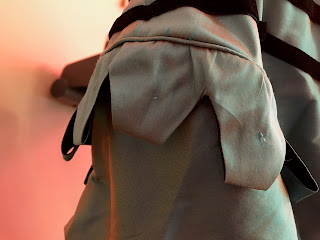I began with one rectangular veil and one demi-moon veil, both done in net. You can also choose to make a veil out of crepe (for mourning, generally) or even silk gauze or like fabrics (these can be done in colors! I've seen period references to brown and blue (mostly) but also to other colors like green!). Generally, veils were either rectangular or demi-moon shaped, as so:
 |
| Rectangular veil; MFA Boston |
 |
| Demi-moon bonnet veil; Metropolitan Museum of Art |
Netted veils were netted as veils, usually; i.e., they were not dotted net with an attached edging. The edging and the dotted part were a single piece that was made. Sadly, the only way to get a real veil like this is to use an original. However, one can approximate a period veil. It will never be 100% authentic, but when is anything we do 100% correct? We still use modern fabric, made with modern machines, dyed with (generally) modern dyes, from modern sources (whether silk worm, breeds of sheep, or modern varieties of cotton and flax). Our goal as living historians is merely to get as close as we possibly can to what 'they' did. Most of us understand that we will never be 100% correct. We can only get close.
Anyway, to approximate a netted veil, you will need 1/2 yard of point d'Espirit (dotted netting), 1 3/4-2 yards of beading, a little less than 4 yards of lace edging, anywhere from 1" to 3" wide, and about 2 yards of black silk ribbon about 1/4" wide. This will make two veils. The links I did provide are where I usually get my supply. I would suggest black for any lace veils as black does it's job (protecting your eyes from the sun's glare) a lot better than white.
The process is simple-cut the point d'Espirit in half and then into your desired shape (rectangular or demi-moon). Be sure to look at originals to get the veil's sizing right for your era. Ebay is awesome because they tend to do measurements more than most museums. Trim out the bottom and sides (for a rectangular veil) or across the curved surface (for a demi-moon veil) with your edging. Run the beading across the top then run the ribbon through the beading. This is to gather up the edge of the veil to fit your bonnet or hat. I generally pin my veils on with a simple straight pin.
It was these directions I followed when I made the bee veil. Of course, I added some beads in the shape of bees and flowers to the material list. The original had flowers and bees made from straw veneer and was not made from dotted netting. It was plain black netting (which is cheaper, but I wanted a guide to be sure all my flowers ended up in the right spot). I could not find straw veneer bees and flowers, and since I did not want to use plastic, I used gold beads. I bought them off Etsy. They do make the bonnet a great deal heavier than before but the effect is lovely and it is not so heavy as to be cumbersome. Here is the completed bonnet veil (worn on the completed 1870's hat):

















